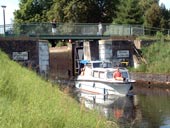The Heegermühle sluice
At the second station, the Heegermühle sluice (2), you can observe one problem concerning the canal. The difference in elevation between Oder and Havel is more than 30 metres. If the rivers were to be connected no water should outflow. Gates had to retain water to guarantee an adequate depth so that ships didn’t aground. In a second step the ships had to be moved a couple of metres downwards. The principles of sluices were known at the time, but an elevation of three or four metres per lock was an almost irresolvable problem. Even the experienced Dutch water builders did not have enough operating experience for that task.
Under elector Sigismund the works were done so far that the first ship crossed the canal in 1609. About 1620 there were already 11 sluices. Finally there was a navigable connection between the Baltic harbour Stettin and the Prussian Berlin. Construction materials, wood, and other goods did not have to be transported over bumpy roads any more. The electoral water board could also take tariffs and sluicing tolls now. But that didn’t last very long. During the Thirty Year’s War (1618 – 1648) the canal silted up more and more. The water flowed unhamperedly towards the Oder and mud and slush filled the canal. The water level of the Havel sank as well until it was barely navigable. Villages and towns were pillaged by different marauding troops. In many places less than a tenth of the former population survived.


